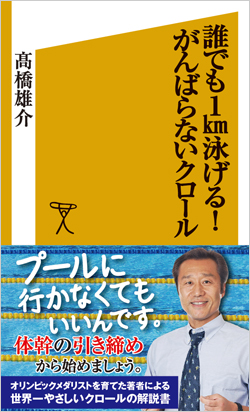Top>Education>Summer is the best time for swimming!
 Index
Index

Yusuke Takahashi [Profile]
Summer is the best time for swimming!
Yusuke Takahashi
Associate Professor of Coaching and Swimming Training Programs, Faculty of Science and Engineering, Chuo University
Introduction
I provide instruction in swimming while serving as an instructor at our university. I am extremely happy to be able to make a living involved with my beloved sport of swimming. Despite my love for the sport, there were times when I felt stifled by the sport. Some times were even so tough that I felt my downfall as a human being. However, I now truly believe that my involvement in swimming enabled me to experience a variety of things. Summer in Japan this year is just one hot day after another-perfect for swimming!
Increase your resistance to stress! Daily training that can easily be done anywhere.
Life in modern society is tough, with countless stresses such as packed trains, deadlines, quotas, and communication with staff members and bosses. I go abroad several times a year for training camps, and I always feel the busyness and bustle of Japan upon returning home. Personally, I wake up shortly after 4 AM in the morning, hold morning practice at the pool, teach classes in the morning, and then return to the pool and hold afternoon practice for about 6 hours. I get home at about 10:30 or 11 PM every night. I then wake up a little after 4 AM the next morning and repeat it all over again. I have continued this lifestyle for nearly 20 years. People often tell me that I seem busy, but I don't feel busy at all. I have become able to honestly say that I enjoy my life and don't feel busy.

Anyone can swim 1 kilometer! The leisurely crawl.
One thing that I look forward to is a training that can be done anywhere. For example, I train myself during the time that I cannot sit in a packed train. This kind of training is actually quite effective for swimming. Within a train, other passengers move in a surprising variety of ways. Some passengers move unexpectedly and sometimes people even come close to falling over when they cannot balance themselves when adjusting to the force of a suddenly departing training. It is possible to train strong muscles for swimming simply by responding to sudden and unexpected forces. Since swimming is performed in water, it is a type of environment without gravity and the ability to balance is required. I currently enjoy training by trying to keep my balance in the train by holding the overhead strap with one hand and standing only on the opposite leg. Balancing on diagonal opposites is exactly the same as the hand-foot timing when swimming the crawl. In this way, I am able to burm up a little energy and to train my muscles during the transportation time that I must be involved in every day. "Little things make a great difference"-this is truly the spirit of training in any place. It is impossible to achieve a toned, lean physique overnight. There are two components which are essential to achieving a toned physique, the first being to burn fat by using energy and the second being to build muscle at the same time by stimulating muscle.
The surprising power of water: Relieving swelling through water pressure
Have you heard the expression "equalize your ears?" This is a technique which must be learned when scuba diving. For example, have you ever felt discomfort in your ears during airplane takeoff or when entering a tunnel in a car or train? This discomfort, including the discomfort experience when swimming, is caused by pressure exerted on the eardrum. An increase of 0.3 atmospheres is equivalent to an altitude of approximately 3,000 meters. However, when diving in water, a difference in pressure of 0.3 atmospheres occurs at a depth of only 3 meters. This means that while we may not experience large differences in pressure while on land, there is the possibility that we can experience such differences relatively easily in the water. This is the reason that scuba diving requires specialized knowledge and technical certification.
When giving swimming lessons to women, I often encourage them by telling them that their legs become slimmer and their waists more slender while swimming. That's right-this is the power of water pressure. To give a specific example of this power, approximately 1 ton of pressure is exerted per 1 m2 of body surface at a depth of 1 meter. The average body surface area for a Japanese woman is 1.5 m2, which means that female swimmers experience a total of 1.5 tons of pressure over their entire body. It is only natural that the body is affected in various ways when exposed to this amount of pressure.
For example, some people experience swelling in their legs from making sales calls or working while standing up. This is the start of a chain reaction of trouble. It may be impossible to relieve fatigued feet or be difficult to remove the boots which you put on in the morning. Symptoms may not heal even when you actively performe self-massage. However, when people with such conditions walk in the water, the symptoms heal almost like magic. Water pressure is entirely responsible for such benefits. Simply by entering a pool about 1 meter deep, the water gently envelops your legs and creates a natural massage effect. When walking in such conditions, this water pressure massage and the pump action of leg muscles (referred to as "venous return" in physiology) makes it easier for the body to return to the heart the fluids and unnecessary substances which have accumulated in the legs. Furthermore, stimulated venous return increases the amount of blood returned to the heart. In turn, this increases the amount of blood sent throughout the body with each beat of the heart (referred to as "stroke volume"). As you can imagine, an increase in stroke volume results in a slower heart rate. Specifically, there is a decrease of approximately 10 beats per minute in a pool with a depth of about 1 meter. This means that the load on the heart is greatly decreased. Conversely, this means that the heart rate measured on land increases by approximately 10 beats per minute when compared to being in the water. This is a great increase in load. Please remember this fact.
Another method for experiencing the power of water pressure is to enter a pool and breathe while submerged up to your shoulders. Exhaling becomes easier, but breathing becomes quite difficult. This is because your lungs are being compressed by water pressure. Although we breathe unconsciously while on land, there is a surprising difference when breathing while subjected to water pressure. As a result, training in the water helps to actively strengthen respiratory muscles. The large chest circumference of swimmers is due not only to big chest and back muscles, but also to the growth of muscles such as respiratory muscles.
So, what do you think? It is nice to pay a lot of money and go get a massage. But, I also think it is nice to get a massage in a pool while actively using energy; that is, while obtaining a slimmer and more toned body. Please give it a try!
The evolution of swimming: Flat swimming theory
I hope that this article has explained how swimming can exert a gentle and effective force on the human body. Personally, there was a time when I was simply focused on continually swimming without giving any thought to the wonderful benefits of water. However, I now hope to convey the outstanding qualities of water to as many people as possible.
Things that were common sense just recently are now outdated and preposterous ideas. This is true not only in swimming but also in various areas of daily life. There may be some people who strongly disagree with my ideas. I don't mind that . However, I would like to share some information on a concept known as flat swimming theory. Then, if you think that I am trying to fool you, please try flat swimming yourself.
Flat swimming theory is a new concept which was realized through a never-ending process of trial and error. The theory itself is quite simple: just strive to remain level with the water surface while swimming. Once you experience the pleasant sensation of floating, you will surely want to swim more. If you swim more, you will build strength and muscle. Before you realize it, flabby areas of your body will become toned and you tackle everyday life with more energy. People are interesting in that confidence in one area naturally leads to success in other areas. I would be overjoyed if people can become happy through flat swimming and find fulfillment doing the crawling.
Chi no Kairo (The Corridor of Wisdom) 7th Issue: Creating teams which take advantage of individuality
http://www.chuo-u.ac.jp/chuo-u/about/a06_02_08_01_j.html![]()
- Yusuke Takahashi
Associate Professor of Coaching and Swimming Training Programs, Faculty of Science and Engineering, Chuo University - Born in Tokyo in 1962. Associate Professor in the Faculty of Science and Engineering, Chuo University.
Advanced Level (Master) Swimming Coach certified by the Japan Sports Association. Member (competitive swimming) of the Japan Swimming Federation. JOC training staff. Competed in the butterfly during his time as a competitive swimmer.
Worked overseas as a coach at Alabama State University, studying the most advanced training techniques. Has served as coach of the Chuo University Swimming Team since 1991. The team won its first Japan Intercollegiate Championships in 1994. Afterwards, Coach Takahashi led the team to 11 consecutive championships, the first such feat in history. His coaching has established numerous Japanese records. Serves as instructor for cultivating Olympic medalists, while also holding swimming lessons for ordinary swimmers. - Research themes
•Coaching
•Swimming training programs
- Research Activities as a Member of Research Fellowship for Young Scientists (DC1), Japan Society for the Promotion of Science (JSPS) Shuma Tsurumi
- Important Factors for Innovation in Payment Services Nobuhiko Sugiura
- Beyond the Concepts of Fellow Citizens and Foreigners— To Achieve SDGs Goal 10 “Reduce Inequality Within and Among Countries” Rika Lee
- Diary of Struggles in Cambodia Fumie Fukuoka
- How Can We Measure Learning Ability?
—Analysis of a Competency Self-Assessment Questionnaire— Yu Saito / Yoko Neha - The Making of the Movie Kirakira Megane








